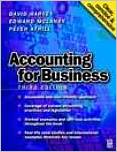| |||||
• polskie
• Zamów informacje o nowościach z wybranego tematu • kontakt |
ACCOUNTING FOR BUSINESSHARVEY D., MCLANEY E.,ATRILL P.wydawnictwo: BH, 2001, wydanie IIIcena netto: Accounting for Business David Harvey Professor
of the Faculty of Commerce, University of Southern Queensland, Toowoomba, Queensland.
In brief Accounting for Business is ideal for undergraduate students on business and accounting courses who need to understand the nuts and bolts of financial accounting. This popular textbook has always enjoyed a deserved reputation for accessibility and thoroughness. Now in its third edition, its contents have been fully updated and restructured to make them even easier to use. Readers will benefit from the coverage of current accounting practices and legislation, in addition to the range of worked examples and self-test activities throughout the book. Accounting for Business
clearly explains accounting information's role in making sound business decisions and
focuses upon the aspects of accounting practice which are most relevant to the
non-specialist manager. It is ideal for first year undergraduates of business studies,
higher students and those pursuing professional accountancy qualifications. Contents Introduction to accounting The main accounting reports; Accounting statements: nature and preparation The balance sheet; The profit and loss account: nature and purpose; The profit and loss account: form and content; The measurement of profit: depreciation; Measurement problems: stock valuation; Profit measurement: bad and doubtful debts; Practical accounting - Practical accounting: ledger accounts; Ledger accounts: further complications; Accounting systems; Accounting for companies: the regulatory framework An introduction to the accounts of limited companies; Accounting for companies; The regulatory framework; The accounts of groups of companies 1; The accounts of groups of companies 2; The analysis and interpretation of accounts The cash flow statement; The use of financial statements for planning and decision making; The analysis of financial statements 1; The analysis of financial statements 2; The analysis of financial statements 3; The conventions and the conceptual framework; Measurement of profit and capital maintenance; Solutions to self-assessment questions. Readership: UK students studying Batchelors courses with finance specialisms. * Students studying AAT, ACCA and CIMA courses. Commonwealth students studying modular business studies courses. * MBA students. * Managers on short executive finance courses. 544 pages
Po otrzymaniu zamówienia poinformujemy pocztą e-mail lub telefonicznie, |


